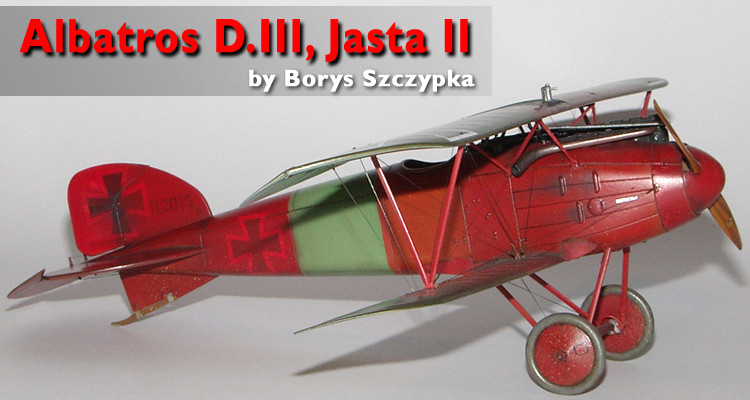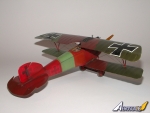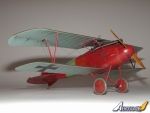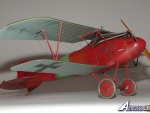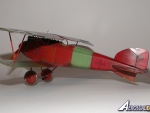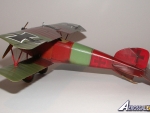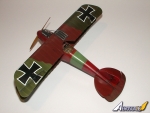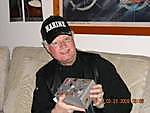1⁄32Albatros D.III
6
Comments
Borys Szczypka built his latest Roden 1:32 Albatros D.III in the colours of Georg Simon, Jasta 11, 1917.
Comments
Nicely done Boris. This depiction of the machine before capture is pretty well done. This aircraft was the subject of one British pilot's log entry.
Noted historian Greg VanWyngarden has in recent years done a small study on the allied impressions of enemy aircraft and has taken time to gather some of these reflections. “...In his marvelous book, Sopwith Scout 7309 the Australian Sopwith Pup pilot Sir Gordon Taylor (66 Squadron) recorded his impressions of flying the captured Albatros D.III 2015/16, ( G.42.)
“...I badly wanted to fly this aeroplane, to discover just what went on in the minds of our opponents when we met them in the air, and to know exactly the strong and weak points of the Albatros performance...I climbed up over the streamlined plywood fuselage, and down into the black leather pilot's seat. I felt immediately how heavy everything was after the light, fabric feeling of the Sopwith Scout. Next I noticed the view from the pilot's seat: excellent, with virtually no blind spots anywhere - a very important feature in a fighting aeroplane....
...The big Mercedes fired on the first swing and turned over slowly with a deep-throated burble from the exhaust. I let it warm up, then ran it up on the chocks to full take-off [power. The noise was savage and impressive after the little LeRhône. I drew back the throttle and waved to McFall (his mechanic) to pull away the chocks...
...The machine moved away with a bellowing roar and began to gather speed. It seemed to run quite a distance before it showed any inclination to leave the ground. Then I could feel the wheels rattling light upon the surface of the stubble field. A little back pressure on the stick and the Albatros was airborne, and away. I held the machine in a steady climb to 1000 feet, then applied the controls to a left-hand turn. Laterally it was quite light, but when I steepened the turn and tried to pull the machine around with the elevator it seemed very heavy, putting up a resistance to the turn. I could see immediately why the Albatros pilots kept out of the close dueling turns...
...I opened the engine out to full throttle again, and tried the climb. It was deceptive. This machine did not go up with the lift-like action of a slow and lightly loaded aircraft, but rather to surge forward, reaching out for height. But it went up, I realized with some disappointment, very convincingly; and when I drew it up to a high angle of climb it seemed for a while to go reaching up, hanging on the propeller. The climb to 3000 feet was a few seconds over three minutes; and to 6000 feet in seven minutes...
...Then I let the nose down. The speed built up steadily, giving me the impression that the heavy Albatros would go on accelerating indefinitely, drawn on by the power of its engine, unopposed by the beautiful, streamlined fuselage. It was fast, that was obvious. As fast as I could judge, its maximum speed was about 125 mph, perhaps a little more...
...I brought the machine in...Its personality was utterly different from our own airy Sopwith scout. Ours was , in some indefinable way, a sporting weapon, with a slightly smiling, light-hearted personality; a machine which did not identify itself readily with the slaughter of war. But this Hun was a war machine, a weapon of ruthless efficiency; cold-blooded in the metal of its V interplane struts, the Spandau guns, the big engine under the streamlined cowl in the nose, and the instruments and fittings in the cockpit... My thoughts, as I got out of the Albatros' cockpit, can be...expressed, "Give me this aeroplane to fight the war. Let me keep the Sopwith Scout to enjoy myself in the air when the war is won...
Mr. VanWyngarden also notes “...Gordon Taylor wrote this in 1965, from memory and referenced to his flight log. There's little doubt he was impressed, even though he'd been forbidden to try aerobatics in the Albatros. He was probably unaware of its tendency toward wing failure !...Cecil Lewis had the opportunity to fly exactly the same machine that Gordon Taylor had, and wrote this in "Farewell to Wings"
"...already in 1917 the Germans were using a 'monocoque' construction of molded ply (far in advance of us) for the body of the Albatros. I don't know what it was made of; but it gave the impression of papier maché. However, it being rounded out like a fish, it was far more roomy and the whole machine seemed larger because of this cavernous cockpit. The water-cooled engine had a neat radiator in the centre-section, but it was big and heavy. In fact the German temperament showed up all along. The machine was sluggish, strong, reliable, and determined. It had none of the feeling of lightness and grace that our aircraft had. Of course, every aeroplane has its own characteristics and very few pilots take over the controls of a strange type and really measure up its capabilities in an hour or so. So it is probable we never really stretched it; but I am certain of one thing - to throw an Albatros about in the air was hard work and it would have made you sweat in a dogfight."
MAR 07, 2014 - 08:01 PM
Borys, another outstanding build. Your weathering is just beyond belief. Really, extremely well done.
Joel
MAR 13, 2014 - 06:40 AM
Stephen,
Thanks so much for the insight into a test flight comparison to a Sopwith Scout. Kind of reminded me of the reverse with the Brut of a P-47 and a Me 109.
Joel
MAR 13, 2014 - 06:46 AM
thank you all for your valuable comments. Description flights wonderful
MAR 14, 2014 - 02:24 AM
This is an interesting scheme with and equally intersting story. As Joel_W stated, another outstanding build, painting well executed. Best
Mark
MAY 01, 2014 - 05:14 AM
Copyright ©2021 by Borys Szczypka. Images also by copyright holder unless otherwise noted. The views and opinions expressed herein are solely the views and opinions of the authors and/or contributors to this Web site and do not necessarily represent the views and/or opinions of AeroScale, KitMaker Network, or Silver Star Enterrpises. Images also by copyright holder unless otherwise noted. Opinions expressed are those of the author(s) and not necessarily those of AeroScale. All rights reserved. Originally published on: 2014-03-08 07:47:29. Unique Reads: 8251




